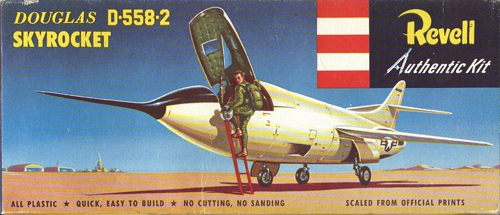
Revell 1/65 Douglas D.558-II Skyrocket
|
KIT # |
0123 |
|
PRICE: |
$10.00 when new |
|
DECALS: |
One option |
|
REVIEWER: |
Steve Eggers |
|
NOTES: |
Reissue of a very old kit. |

|
HISTORY |
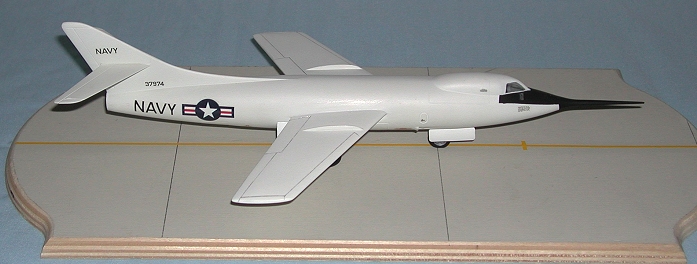
On November 20, 1953, the Douglas D-558-2 Skyrocket became the first aircraft to fly faster than Mach 2, twice the speed of sound. Piloted by A. Scott Crossfield, it was air-launched from a U.S. Navy Boeing P2B-1S (B-29) the swept-wing, rocket-powered D-558-2 reached Mach 2.005 in a shallow dive at 18,898 meters (62,000 feet). This swept wing research plane attained Mach 2.005 (1,291 mph) while in a shallow dive at an altitude of 62,000 feet. Seconds afterward, the plane’s XLR-8 rocket engine exhausted its fuel supply and shut down. Crossfield glided earthward to a smooth dead-stick landing on Muroc Dry Lake, at Edwards Air Force Base, California.
D-558-2 #2 was just one of six different D558 research airplanes ordered
by the U.S. Navy from the Douglas Aircraft Company for obtaining
aerodynamic 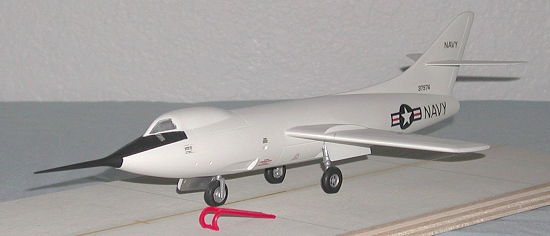 information at transonic and supersonic speeds. The Navy
issued a letter of intent to Douglas on June 22, 1945, for construction
of six Model D-558 aircraft, having straight, thin wing and tail
surfaces, and turbojet propulsion.
information at transonic and supersonic speeds. The Navy
issued a letter of intent to Douglas on June 22, 1945, for construction
of six Model D-558 aircraft, having straight, thin wing and tail
surfaces, and turbojet propulsion.
The D-558-1 and D-558-2 greatly differed from one another in detail design and there was little commonality between them. Both took off from the ground. Because of its engine type and airframe design, the D-558-1 was limited to approximately Mach 1, the speed of sound. The more powerful D558-2, using its 6,000-pound-thrust rocket engine fueled with liquid oxygen and diluted ethyl alcohol, could easily exceed Mach 1. The safety hazards of operating a heavily loaded rocket-propelled airplane from the ground later caused Douglas to modify the D-558-2 #2 and #3 for air launching from the bomb bay of a converted Boeing P2B-1S (Navy B-29) Superfortress. At the same time, Douglas modified the D-558-2 #2 to all-rocket propulsion, utilizing the space formerly taken up by its turbojet engine for additional rocket fuel. Thus modified, the D-558-2 #2 was capable of reaching Mach 2, which it did while being flown in a special high-speed flight research program by the National Advisory Committee for Aeronautics (NACA).
The D-558-1 and D-558-2 were of mixed aluminum and magnesium construction. Both types featured jettisonable nose sections to serve as emergency escape capsules. and both were designed to carry heavy instrumentation payloads for flight research purposes. The first two D-558-1 Skystreaks were bright glossy red overall, but the D-558-1 #3 and later D-558-2 Skyrockets were glossy white, which proved more desirable for optical tracking purposes. The historic Douglas D558-2 #2, NACA 144, the first Mach 2 airplane, is in the collection of the National Air and Space Museum.
|
THE KIT |
Revell’s Skyrocket kit was originally released in 1955, with subsequent releases in the 1960’s and most recently in 1994 as part of Revell’s SSP Limited Run model kits.
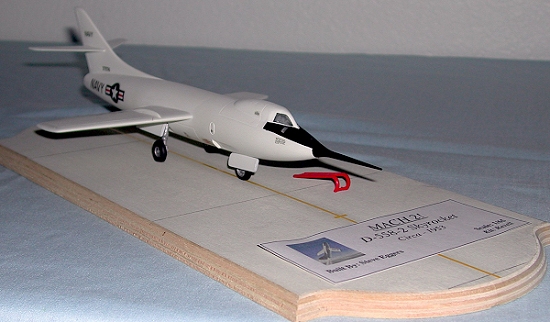 The kit represents Douglas Skyrocket D-558-2 #2, BuNo 37974, NACA
144.
The kit represents Douglas Skyrocket D-558-2 #2, BuNo 37974, NACA
144.
The kit is an odd, “fit-the-box”, 1/65 scale. The kit contains 22 parts molded in white and clear plastic, and contains a ladder and a pilot figure. Notably, this kit has recessed panel lines, what panel lines it has.
|
CONSTRUCTION |
As with all early scale model kits from that era, the plastic is thick, the parts don’t line up quite right, and some filling and sanding is required. There were some sink holes just below the canopy on both sides of the fuselage, but nothing that filling and sanding couldn’t take care of. Care had to be taken with the wing alignment. It took me several attempts to get it right. The landing gear had to be sanded a little bit to correct the stance of the model.
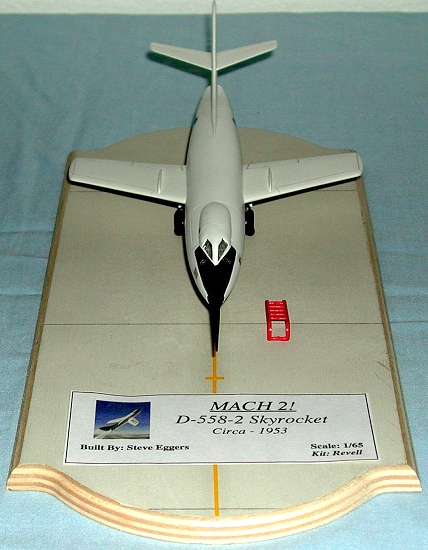 The wheels provided in the kit, left a lot to be desired, I decided to
go to the spares box and find some better looking wheels for the kit.
The wheels provided in the kit, left a lot to be desired, I decided to
go to the spares box and find some better looking wheels for the kit.
|
COLORS & MARKINGS |
All of the Skyrockets were painted and overall Gloss White with Flat Black anti-glare in front of the windscreen. I painted the entire model with several coats of flat white. After the paint had thoroughly dried, I sanded the entire model with 2000 grit wet/dry. This smoothed out the paint and gave a semi-gloss appearance.
I decided to use the kit decals provided, even though I knew the national insignia was incorrect. I wanted to go with a nostalgic feel on the kit. The kit decals went on well, I then went to the spares box and looked for “appropriate” stencils to place in various locations on the aircraft.
|
CONCLUSIONS |
I got this model as a freebie. I originally wasn't going to build it, but after I did some research on the subject, I had a change of heart. This was a fun model to build, sure I could have gone crazy with it, but I didn’t.
I was so inspired by this kit, that I found Revell’s X-3, X-5, and X-15 kit to complete the collection. I know all the kits are odd scales, but they will look good sitting on the shelf together.
Steve will be interested to know that I have that image on his base as a lithograph on my wall; signed by Scott Crossfield and everything. Ed
August 2004
Copyright ModelingMadness.com
If you would like your product reviewed fairly and fairly quickly, pleasecontact the editor or see other details in the Note to Contributors.